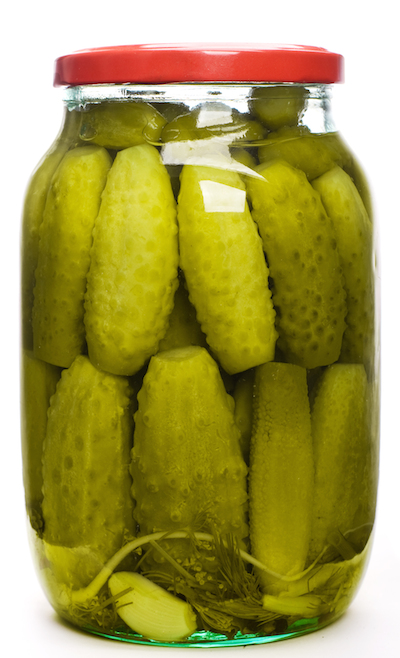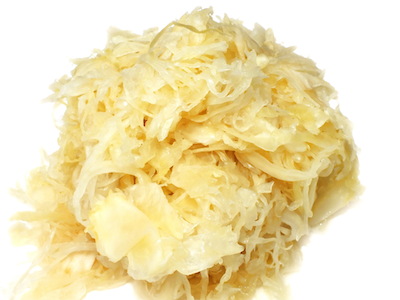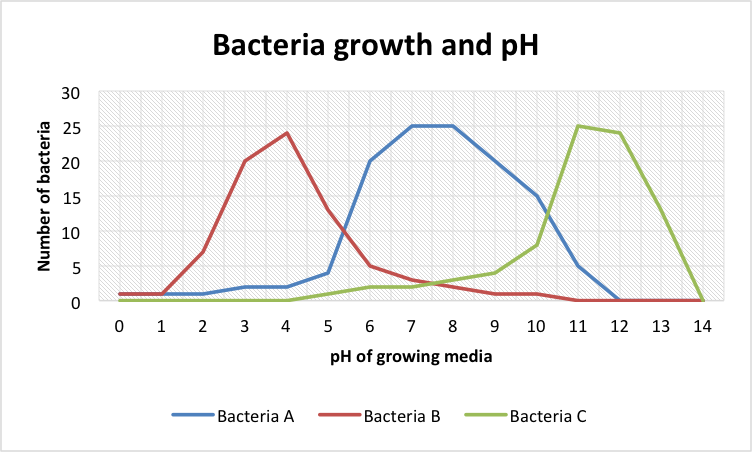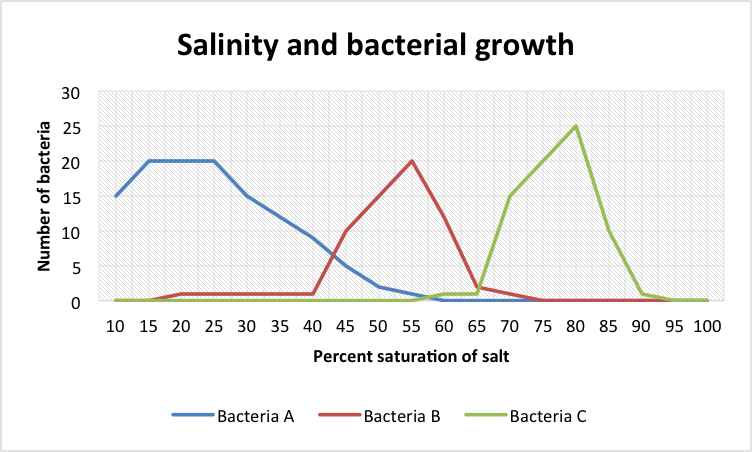
Chapter 4. Pickling and Fermentation
Pickling and Fermentation

Read the article below. Then answer the questions that follow.

Bacteria to the future
In trendy places like Seattle and the Williamsburg area of Brooklyn, the art of pickling is coming back after a couple of generations of fading from memory. If you decide to give it a try, you may notice that each pickle jar may have a slightly different aroma and flavor—even though you follow your Great Aunt Mill’s time-tested family recipe to the letter.
Does this mean you’ve done something wrong? Not necessarily. Pickle flavor can vary from jar to jar because the bacteria responsible for pickling grow a little differently with each batch.
Pickling is a type of fermentation
Pickling begins by placing cucumbers in a salty solution called brine. This mixture might include spices to enhance flavor, and is usually brought to a boil before it’s poured over the cucumbers. Naturally-occurring bacteria then transform the cucumbers into pickles.
Like beer, wine, and even cheese, pickles are fermented. Briefly put, this involves microbial organisms that convert sugars into acids. This not only creates a unique flavor, it also makes it harder for the bad microbes that cause rot to survive.
Luckily for pickle connoisseurs, the microbes responsible for fermentation are uniquely capable of surviving in this acidic, carbohydrate-deprived environment. The inside of a pickle jar is also oxygen deprived, so fermentation bacteria must also be anaerobic (capable of growing without oxygen). Most of the microbes responsible for pickling are called lactic acid bacteria. They break down glucose, fructose, and sucrose sugars into lactic acid, which is associated with sour tasting foods, and helps curdle milk. They also make other acids that contribute to flavor.
Pickling & The World
Pickling may be making a comeback here in the United States, but it never went away elsewhere. It is popular worldwide.
In parts of Asia and Africa, lactic acid fermentation is still a primary method of food preservation—especially in regions where canned and frozen foods are unavailable. Fish, mangoes, and olives are all pickled.
Because fermentation requires little mechanical energy and processing, many researchers believe it will become even more important as the world’s population continues to rise.
Two types of bacteria determine taste
Some lactic bacteria convert sugars to one end product alone—lactic acid. Others make lactic acid alongside other products. Both types of bacteria are at work during pickling.
Bacteria that make only lactic acid are called homofermenters. They use an enzyme called aldolase to break down six-carbon sugars like glucose and fructose. As a result, two molecules of lactic acid are made, as well as two molecules of Adenosine Triphosphate (ATP)—the fundamental unit of energy for the cell. These bacteria contribute to the sour taste you get when sampling a pickle.
Heterofermenters only use aldolase in small amounts, and produce just one molecule of lactic acid per sugar molecule. While you might think these bacteria produce less flavor because they make sour molecules in less quality, heterofermenters actually play a more important role in creating flavor. This is because they also make acetic acid and a list of smaller sugars, which contribute to the taste and aroma of the final pickle.
As we will see, this process of converting sugar into acid and smaller carbohydrates also preserves the pickle.
Pickling for preservation
As you might expect, lactic acid makes the pH drop inside the pickle jar. The pH can hit 3.4-3.6 after only a couple of weeks of pickling.
Just like any other acidic environment, the inside of a pickle jar isn’t hospitable to most forms of bacteria once fermentation gets going. While lactic acid bacteria are capable of surviving in this harsh acidic environment, the organisms responsible for rotting food cannot.
As the pH drops, lactic acid bacteria overwhelm the microbial community. The most sensitive lactic acid bacteria grow and reproduce first, before the pH drops. More acid-tolerant bacteria come next, and finally a hardy bacteria called Loctobocillus plantarum finishes the fermentation process. L. plantarum can tolerate the final pickling environment.
In addition to producing lactic acid, these bacterial fomenters also make a product you may have in your medicine chest—hydrogen peroxide. This has an antimicrobial effect on the other critters in the jar, even though lactic acid bacteria themselves are resistant to it.

Controlling pickle bacteria with salt
Even if you use the same recipe, each batch of pickles has a different cocktail of microbes. This is because differences in the temperature and saltiness of the brine favor different types of lactic acid bacteria.
Masters (perhaps including your great aunt) can strategically manipulate these conditions to make the perfect pickle. For example, dill pickles are fermented in lower salt concentrations, which are good environments for Leuconostoc bacteria. The small amounts of ethanol and acetic acid produced by these bacteria help finish the flavor.
These bacteria play less of a role when fermenting cabbage into sauerkraut. This is why sauerkraut preparation involves salting the cabbage—a process that discourages salt-sensitive Leuconostoc bacteria, and also dries the cabbage by removing water from the cells of the cabbage by osmosis.
Before refrigerators, it was even more critical to create the perfect pickling conditions. Pickling kept food from rotting during the hot summer, and was used to preserve food for the winter. This is why some of the best pickling recipes were handed down over generations, and why pickling is sometime we can do to connect us with our past.
“On a hot day in Virginia, I know nothing more comforting than a fine spiced pickle, brought up trout-like from the sparkling depths of the aromatic jar below the stairs of Aunt Sally’s cellar.”
Thomas Jefferson
© 2015 WH Freeman and Company.
4.1 Comprehension Questions
Answer the following questions to demonstrate your understanding of the article.
1.
Complete the following paragraph:
Pickling involves two groups of bacteria classified according to the product(s) they produce. One group is called , which only produce lactic acid, and the other group of bacteria is called , which produce lactic acid, acetic acid, and a number of small sugars, all of which contribute to the taste and smell of pickled food.
2.
Some lactic acid bacteria produce ______________, a common disinfectant you might find in your medicine cabinet.
| A. |
| B. |
| C. |
| D. |
| E. |
3.
Complete the following paragraph:
To encourage fermentation, cucumbers are added to brine, which is a solution. Bacteria that lead to fermentation are anaerobic, which means the environment inside a pickle jar is -deprived.
4.
True/False:
Homofermenter bacteria use an enzyme called aldolase to break down six-carbon sugars to produce two molecules of lactic acid and 32 Adenosine Triphosphate (ATP) molecules for each sugar molecule.
5.
Despite its recent revival in popularity, why is pickling not as widely used today compared to past generations?
| A. |
| B. |
| C. |
| D. |
| E. |
6.
Fill in the missing words:
Sauerkraut preparation involves adding large amounts of to cabbage, which growth of Leuconostoc bacteria. It also removes water from the cabbage cells by the process of .
7.
Production of lactic acid lowers the pH of pickling brine to 3.4 – 3.6. Which statement best describes the benefit(s) of having an acidic brining solution when making pickles?
| A. |
| B. |
| C. |
| D. |
| E. |
8.
Why does the flavor of pickles vary even when the same recipe is used?
| A. |
| B. |
| C. |
| D. |
| E. |
9.


Using the data presented in the two graphs above, choose which bacteria (A, B, or C) is best suited for each of the following conditions. (Note: You may click on each graph for a zoomed-in view.)
Condition 1: A growing media with a pH between 3 and 4 and salinity range between 50% and 55%.
Condition 2: A growing media with a pH between 11 and 13 and salinity range between 75% and 85%.
Condition 3: A growing media with a pH between 7 and 8 and salinity range between 15% and 25%.
10.
Your Great Aunt Mill makes a batch of her famous pickles. A few weeks pass, and she realizes that she didn’t follow the recipe correctly: her pickling brine solution contained plenty of spices but almost no salt! She immediately throws the batch of pickles in the garbage. Was she justified in throwing them away? Why or why not?
| A. |
| B. |
| C. |
| D. |
| E. |
Activity results are being submitted...